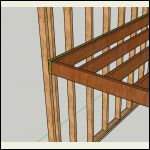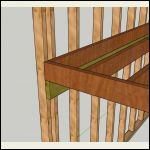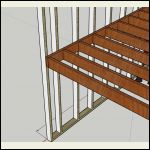|
| Author |
Message |
Paul_w
Member
|
# Posted: 2 Oct 2018 03:05am
Reply
Hi all.
I'm planning on building a sort of an open second floor as a sleeping area. It'll be around 2x2 meters in size, placed into one of the cabin's corners, and the current plan is to attach it direct to the wall's 2x4s with joist hangers and support from the open corner with a beam coming up from the floor.
Or instead of attaching it direct to the vertical wall joists, would it be better to run a horizontal joist across the wall first and then rest the sleeping area frame on that instead?
I hope I'm clear on the thought process. I'm looking into free cad-type software that would allow me to draw it out..
Thanks!
|
|
Princelake
Member
|
# Posted: 2 Oct 2018 06:23am
Reply
I would think running a floor joist attaching it to the wall first so you have lot more wood there when nailing on your joist hangers.
|
|
Paul_w
Member
|
# Posted: 2 Oct 2018 08:11am - Edited by: Paul_w
Reply
You mean something like these images? The second one would be the stronger option I imagine?
Edit: Or am I making it too complicated and the solution depicted on the third image will do just fine?
on.jpg
| 
ontopof.jpg
| 
simpler.jpg
|  |
|
|
ICC
Member
|
# Posted: 2 Oct 2018 09:36am
Reply
Is the main wall structure already built or is this going to be added to something already built? What size are the wall studs?
|
|
Paul_w
Member
|
# Posted: 2 Oct 2018 09:39am
Reply
Walls aren't up yet but will be made up of 2x4s. The material is here, just waiting for a non-rainy day to start getting them up.
|
|
SE Ohio
Member
|
# Posted: 2 Oct 2018 10:20am
Reply
Not to address your building question, but something to keep in mind, that is, heat rises. We have a 14' x 24' cabin with an open loft, and it is too hot up there when the lower cabin is comfortably heated in winter. Might consider being able to close off area to keep heated air out most of the time?
|
|
Paul_w
Member
|
# Posted: 2 Oct 2018 10:39am
Reply
That's one of the reasons actually. Since the walls are 2x4 there won't be that much room for insulation, so at night I thought about having a warmer area to sleep in. Don't mind the chilliness either if doesn't pan out though.
|
|
Paul_w
Member
|
# Posted: 2 Oct 2018 11:38am - Edited by: Paul_w
Reply
Here's a more complete view (don't mind my shoddy skills with the software). Would be supported like this instead of with just a single post in the corner. This approach also creates an interesting semi-wall I think (can make shelves between the joists etc).
Structurally overall is this a sound solution for an elevated area like this? The cabin's outside walls are 2x4, and the sleeping area's floor and the wall supporting the sleeping area inside the cabin can be 2x6.
|
|
|
Princelake
Member
|
# Posted: 2 Oct 2018 12:10pm
Reply
I dont feel a ledger board is needed. And you can have just a post in the corner along as its supported underneath it. I'm assuming your doing some type of pad and pier with an elevated cabin. Just make sure you put a pad and pier under your post. And I agree that lofts are hot places. Even sleeping on the top bunk in a wood heated cabin can be unpleasant
|
|
Paul_w
Member
|
# Posted: 2 Oct 2018 01:37pm
Reply
Without a pier directly below the post though, the visual above with the extra wall is still reasonable?
|
|
ICC
Member
|
# Posted: 2 Oct 2018 06:01pm - Edited by: ICC
Reply
For what you want, if the walls have not yet been erected I would use a let -in 1x4 as a ledger board. The easiest, and best, way to cut the slot in the framing is to clamp the studs together on the floor deck before erecting the wall. Use a router and guide strips to cut a 3/4" deep slot or groove in the 6 or 7 studs that will be supporting the loft floor. This is how entire second story floors were framed and supported back when balloon framing was common. It is still approved by the IRC.
The floor joists sit on the 1x4 ribbon ledger and also have their ends nailed to each wall stud. The floor joists must be nailed to the wall stud as well as sitting on the 1x4 ribbon.
EDIT: A main floor wall as drawn would distribute the load better than a single corner post as I was first thinking. That would be better but also should be oriented so the support wall is built across, perpendicular to, the floor joists.
No reason to use 2x6 inside unless you just want a thicker wall. I'd build the exterior with 2x6 myself mostly because I'd want the insulation.
As others have said lofts are always hotter than the main floor. If given a choice of sleeping in a loft or on the floor downstairs in a sleeping bag I'd choose the floor and the bag over a loft almost anytime.
|
|
rockies
Member
|
# Posted: 2 Oct 2018 08:51pm
Reply
I agree that the extra ledger board isn't needed but I would not cut a notch for a "let-in" ledger board into a 2x4 stud. The stud is only 3 1/2" wide and if you cut away 1 1/2" (the thickness of the ledger board) you only have 2" of stud left in that spot.
I would just attach your ledger board to the inside surface of your wall stud using lag bolts instead of just nails. The interior wall looks nice, but you could also go the route of installing an interior pass-through in that wall to open it up a bit more (maybe creating a bar counter).
|
|
ICC
Member
|
# Posted: 2 Oct 2018 09:58pm - Edited by: ICC
Reply
I would not cut a 1-1/2" deep notch in a 2x4 stud either. But a 1x4 is 0.75" thick, not 1.5 inch.
If for some reason one does not think that 3/4" wide surface can support the load reference span tables or the AWC calculator. As an example a 2x12 DF select structural floor joist can safely span over 21 feet, 16" OC, and only requires a bearing surface at each end of 3/4"....see attached screenshot.... bearing length is the second line. And that is for a 21 foot full floor load span. A shorter span with limited load requires much less bearing surface.
Studs may be notched up to 25% of the stud depth according to IRC.
The advantage to the IRC approved let-in ribbon is it provides a wood ledge for the ribbon ledger to sit on. The fasteners used to hold the 1x4 only have to keep the 1x4 in place. The fasteners support no vertical loads, no shear loads. Stacking the load path from one wood surface to the next vertically is preferred over using nails, screws or bolts to carry the loads.
Lag screws may be sized to provide ample strength to support the vertical loads when a ledger is simply fastened to the stud face. The potential issue then becomes the strength, the integrity of the wood members. Any splitting of the wood fibers around the hole the lag screw makes negates any strength inherent to the fastener.
The biggest advantage a screw has over a nail is withdrawal resistance. Often it is better to use a grouping of nails instead of one larger screw or bolt, as the fiber loading on the wood is spread wider. Of course if withdrawal resistance is required that changes things.
|
|
Wilbour
Member
|
# Posted: 3 Oct 2018 04:44am
Reply
Check previous posts. This has been debated before and some interesting reading for sure.
I'm still satisfied with what I did. I put additional 2x4s along side of my wall studs but they are only as high as my loft. The joists for the loft sit directly on top of these shorter studs. No worry about the strength of the nails as the weight is transferred directly to the floor.
|
|
Paul_w
Member
|
# Posted: 3 Oct 2018 07:00am
Reply
Wilbour Do you have any images you could share of your solution? That sounds interesting. Would save the effort of cutting notches and the extra support right next to the wall could be designed into a shelf system or something like that also.
Love the idea presented by rockies as well.
|
|
Wilbour
Member
|
# Posted: 3 Oct 2018 04:10pm
Reply
Stole this from the Infoweb
Essentially its like building a door frame except instead of placing the header across the opening, you run the loft joist perpendicular so it sticks out of the wall.
The "Jack Stud" bears the weight.
Downside is slightly less insulation in the wall cavity but double the wall studs for mounting stuff
|
|
Wilbour
Member
|
# Posted: 3 Oct 2018 04:11pm - Edited by: Wilbour
Reply
Place these as often as you need loft joists.
Mine are covered now and I don't think I took a photo while building.
If I remember correctly my walls were so poorly built (previous owner) that the studs didn't always line up from one side to another. I may have even built what looks like a door opening in the above photo and place the floor joist on top of that. Definitely did that above the 4ft window
So essentially you will space your floor joist as your wall studs are
|
|
Wilbour
Member
|
# Posted: 3 Oct 2018 04:26pm
Reply
See this photo. You have to look carefully.
My post from this thread
http://www.small-cabin.com/forum/2_4656_0.html#msg68931
|
|
Paul_w
Member
|
# Posted: 4 Oct 2018 04:03am
Reply
Beautiful, thanks so much.
|
|
Borrego
Member
|
# Posted: 4 Oct 2018 12:03pm
Reply
Do you need that wall, or would a post be ok with you? That would work too.....
|
|
Paul_w
Member
|
# Posted: 5 Oct 2018 04:34am
Reply
Don't need the wall but I think it's better if the weight is more evenly distributed since I don't have a foundation post below where the sleeping area post would be.
|
|
|

